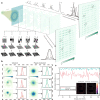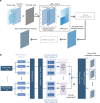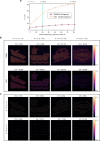Super-resolution orbital angular momentum holography
- PMID: 37015931
- PMCID: PMC10073211
- DOI: 10.1038/s41467-023-37594-7
Super-resolution orbital angular momentum holography
Abstract
Computer-generated holograms are crucial for a wide range of applications such as 3D displays, information encryption, data storage, and opto-electronic computing. Orbital angular momentum (OAM), as a new degree of freedom with infinite orthogonal states, has been employed to expand the hologram bandwidth. However, in order to reduce strong multiplexing crosstalk, OAM holography suffers from a fundamental sampling criterion that the image sampling distance should be no less than the diameter of largest addressable OAM mode, which severely hinders the increase in resolution and capacity. Here we establish a comprehensive model on multiplexing crosstalk in OAM holography, propose a pseudo incoherent approach that is almost crosstalk-free, and demonstrate an analogous coherent solution by temporal multiplexing, which dramatically eliminates the crosstalk and largely relaxes the constraint upon sampling condition of OAM holography, exhibiting a remarkable resolution enhancement by several times, far beyond the conventional resolution limit of OAM holography, as well as a large scaling of OAM multiplexing capacity at fixed resolution. Our method enables OAM-multiplexed holographic reconstruction with high quality, high resolution, and high capacity, offering an efficient and practical route towards the future high-performance holographic systems.
© 2023. The Author(s).
Conflict of interest statement
The authors declare no competing interests.
Figures









References
-
- Zhou T, et al. Large-scale neuromorphic optoelectronic computing with a reconfigurable diffractive processing unit. Nat. Photonics. 2021;15:367–373. doi: 10.1038/s41566-021-00796-w. - DOI
-
- Lin S, Wang D, Wang Q, Kim E. Full-color holographic 3D display system using off-axis color-multiplexed hologram on single SLM. Opt. Laser Eng. 2020;126:105895. doi: 10.1016/j.optlaseng.2019.105895. - DOI
Grants and funding
LinkOut - more resources
Full Text Sources

